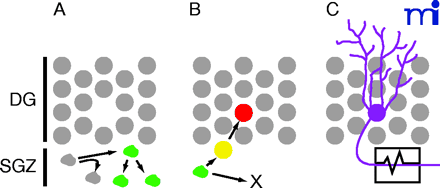
- Institution: Stanford Univ Med Ctr Lane Med Lib/Periodical Dept/Rm L109
- Sign In as Member / Individual
A Neurogenic Theory of Depression Gains Momentum

Process of neurogenesis. Neurogenesis in the adult hippocampus is a process that includes progression from cell proliferation through lineage commitment and functional integration. A. Self-renewal and Proliferation Phase. Resident neural stem cells in the subgranular zone (SGZ) below the hippocampal dentate gyrus (DG) occasionally undergo cell cycle, producing progeny that either retain their stem cell-like nature (self-renewal) or begin a process of lineage commitment as neural progenitor cells (green). The progenitor cells act as a reserve of cells that can be expanded under the influence of environment factors, such as antidepressants. B. Survival and Differentiation Phase. Under appropriate environmental conditions, some progenitor cells (green) progress in their lineage commitment (yellow) and move into the granule cell layer where they begin to express markers characteristic of mature neurons (red). This represents the process of differentiation into neurons. Other progenitor cells may commit to become astrocytes or die (X). This process is typically complete within one or two weeks from the progenitor cell’s “birthdate” when it exits from cell cycle. C. Maturation and Functional Integration Phase. Newly generated neurons eventually establish a morphology consistent with neuronal function such as the elaboration of a dendritic arbor, formation of dendritic spines and synapses, axonal extension, and the ability to conduct action potentials.


